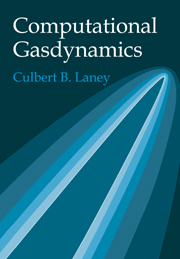Book contents
- Frontmatter
- Contents
- Preface
- Chapter 1 Introduction
- Part I Gasdynamics Review
- Part II Computational Review
- Part III Basic Principles of Computational Gasdynamics
- Part IV Basic Methods of Computational Gasdynamics
- Chapter 17 Basic Numerical Methods for Scalar Conservation Laws
- Chapter 18 Basic Numerical Methods for the Euler Equations
- Chapter 19 Boundary Treatments
- Part V Advanced Methods of Computational Gasdynamics
- Index
Chapter 17 - Basic Numerical Methods for Scalar Conservation Laws
Published online by Cambridge University Press: 07 December 2009
- Frontmatter
- Contents
- Preface
- Chapter 1 Introduction
- Part I Gasdynamics Review
- Part II Computational Review
- Part III Basic Principles of Computational Gasdynamics
- Part IV Basic Methods of Computational Gasdynamics
- Chapter 17 Basic Numerical Methods for Scalar Conservation Laws
- Chapter 18 Basic Numerical Methods for the Euler Equations
- Chapter 19 Boundary Treatments
- Part V Advanced Methods of Computational Gasdynamics
- Index
Summary
Introduction
This chapter surveys simple classic methods for scalar conservation laws. As seen in Part III, the six basic design techniques used in computational gasdynamics are as follows:
flux averaging (Section 13.3),
flux and wave speed splitting (Sections 13.4 and 13.5),
numerical integration and numerical differentiation (Chapter 10),
Cauchy–Kowalewski (Section 15.3),
method of lines (Subsection 11.2.1), and
reconstruction–evolution (Section 13.6).
The numerical methods found in this chapter use all of these derivational techniques, albeit in the simplest possible ways. To begin with, Section 17.1 derives the Lax–Friedrichs method using numerical differentiation and the method of lines. Section 17.2 derives the Lax–Wendroff method using the Cauchy–Kowalewski technique and numerical differentiation. Section 17.3 derives three first-order upwind methods using reconstruction-evolution and numerical integration. Section 17.4 derives the Beam–Warming second-order upwind method using the Cauchy–Kowalewski technique, numerical differentiation, and flux splitting. Finally, Section 17.5 derives Fromm's method using a simple fixed flux average of the Lax–Wendroff method and the Beam–Warming second-order upwind method.
To help evaluate the numerical methods found in this chapter, consider the following twelve-point checklist based on the material found in Part III:
Artificial viscosity (Chapter 14, Sections 15.1, 15.3, and 16.4).
CFL condition (Chapter 12).
Conservation (Chapter 11).
Consistency (Sections 11.1, 15.3, 15.4 and 16.11).
Convergence (Sections 15.4 and 16.11).
Explicit versus implicit (Sections 11.1 and 12.1).
Finite volume versus finite difference (Chapter 11).
Linear stability (Section 11.1, Chapter 15).
Linear versus nonlinear (Chapters 15 and 16).
Nonlinear stability (Sections 11.1 and 12.1, Chapter 16).
Order of accuracy (Sections 11.1 and 11.2).
Upwinding and stencil selection (Chapter 13).
- Type
- Chapter
- Information
- Computational Gasdynamics , pp. 309 - 350Publisher: Cambridge University PressPrint publication year: 1998



